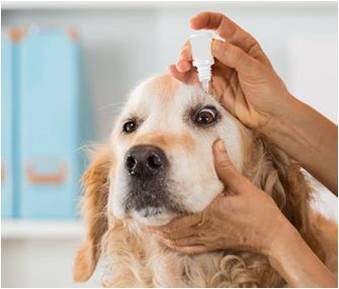How to Apply Eye Medications to Your Dog and Cat
A Step-By-Step Guide to Applying Eye Medications to Your Dog and Cat
Administering eye medications to your pet can be a challenging task, but it’s essential for maintaining their eye health and treating various conditions. Whether using eye drops or ointment, applying these medications carefully will ensure your pet gets the treatment they need, while minimizing stress for both of you. This guide provides step-by-step instructions to help you confidently apply eye medications to your pet.
Applying Eye Drops to Your Pet
Eye drops are commonly prescribed to treat conditions like dry eye, conjunctivitis, or eye infections. Here’s how to apply eye drops safely and effectively:
1. Ensure the Face is Clean
Start by wiping away any discharge or debris around your pet's eyes. This ensures the medication is applied to a clean surface.
2. Position Your Pet
Small Dogs or Cats: Place them on a table, countertop, or hold them in your lap for more control.
Larger Dogs: It’s often easier to apply eye drops while they’re on the floor. Use a rubber-backed rug to prevent slipping.
3. Tilt the Head
Gently tilt your pet’s head back so they’re looking toward the ceiling. Be cautious if your pet has arthritis or a short neck, as you don’t want to strain them.
4. Prepare the Eye
Use your palm or a finger to gently lift the skin just above the upper eyelid, creating a small pocket to hold the drop.
5. Apply the Drop
From behind your pet, carefully squeeze one drop of the medication into the eye. Avoid applying more than one drop, as excess medication will simply roll out of the eye.
6. Let the Eye Close Naturally
Allow your pet to blink and close their eye after the drop is applied. Avoid letting them shake their head or paw at the eye, as some drops may sting initially.
7. Reward Your Pet
Once the medication is applied, reward your pet with a treat to create a positive association with the process.
8. Use a Towel Wrap if Necessary
If you are having difficulty controlling your pet, wrap them in a towel or trap them between a chair or sofa arm and your body to prevent sudden movements.
9. Avoid Contamination
Never allow the dropper tip to touch your pet’s eye to prevent contamination of the medication.
How Long Will a Bottle Last?
A typical 1 milliliter bottle of eye drops contains about 20 drops. If your pet needs one drop in each eye twice a day, a 5 milliliter bottle should last around 25 days.
With these simple steps, you’ll be able to administer eye drops to your pet safely and effectively, making the process easier for both you and your pet.
Applying Eye Ointment to Your Pet
Eye ointments are often used for more intense treatments or conditions that require a thicker medication to stay in place. Here’s how to apply ointment to your pet’s eyes:
1. Clean the Area Around the Eye
As with eye drops, begin by cleaning your pet’s face to ensure there are no hairs or debris obstructing the eye.
2. Prepare the Ointment
Open the cap of the medication and place the tube on a clean, flat surface, such as a paper towel or napkin.
3. Restrain Your Pet
Gently restrain your pet as needed. You may need a second person to help, or use a towel to keep them still.
4. Apply the Ointment
Tilt your pet’s head back and either lift the upper eyelid or gently part both eyelids. Squeeze a ¼-inch line of ointment directly onto the eye (NOT the eyelid itself).
5. Let the Ointment Melt
After applying the ointment, allow the eye to close naturally. The heat from the eye will help the ointment melt. Avoid rubbing the eye.
6. Prevent Rubbing
Do not allow your pet to rub at their eyes afterward. If needed, consider using an e-collar to prevent them from touching their face.
Additional Tips for Success
1. Medications Should Not Be Shared
Do not share your pet's eye medications with other pets or use them on yourself.
2. Handle with Care
For certain medications, such as mydriatics or immunosuppressants, wash your hands thoroughly after use. Wearing gloves is advisable when handling these medications.
3. Know Which Eye to Treat
Ensure that you know which eye requires treatment—left or right (or both)—so there’s no confusion.
4. Monitor for Signs of Progression
Be aware of any worsening symptoms in your pet’s condition. If the eye problems seem to be getting worse, contact your veterinarian or a veterinary ophthalmologist for guidance.
5. Consider an E-Collar
If you’re concerned that your pet might rub at their eyes after treatment, it’s a good idea to use an e-collar. A rigid plastic collar or a comfy cone (soft foam core) can help prevent this.
Conclusion
Applying eye medications to your pet may seem tricky at first, but with patience and the right technique, it will become easier over time. Follow these steps carefully to ensure the medication is applied correctly, and always remember to reward your pet for good behavior. By taking the time to apply these treatments correctly, you can help keep your pet’s eyes healthy and comfortable. If you encounter difficulties or notice signs of worsening conditions, don’t hesitate to reach out to your veterinarian for advice.
Valerie Hayden, LVT, RVT, CVT



